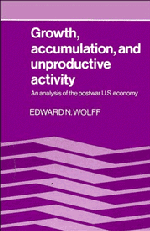Book contents
- Frontmatter
- Contents
- Preface
- 1 Introduction
- 2 Unproductive activity in a capitalist society
- 3 A Marxian accounting framework
- 4 A growth model of accumulation and unproductive labor
- 5 Rise of unproductive activity in postwar economy
- 6 Absorption of labor and capital and rate of surplus value
- 7 Absorption of new resources and growth in real income
- 8 Conclusions and speculations
- Appendix: Data sources and methods
- References
- Index
Appendix: Data sources and methods
Published online by Cambridge University Press: 24 March 2010
- Frontmatter
- Contents
- Preface
- 1 Introduction
- 2 Unproductive activity in a capitalist society
- 3 A Marxian accounting framework
- 4 A growth model of accumulation and unproductive labor
- 5 Rise of unproductive activity in postwar economy
- 6 Absorption of labor and capital and rate of surplus value
- 7 Absorption of new resources and growth in real income
- 8 Conclusions and speculations
- Appendix: Data sources and methods
- References
- Index
Summary
The data for the components of the standard input–output accounting framework were assembled from a variety of sources described below. All estimates are reconciled with the National Income and Product Accounts where possible. The basic data can be divided into six components: (1) the commodity flow table, (2) labor coefficients, (3) capital matrix, (4) sectoral price deflators, (5) personal taxes, and (6) industry by occupation matrix.
Commodity flow tables
The standard 87-sector Bureau of Economic Analysis (BEA) scheme is shown in Table A.1. Sector 74, research and development, exists as a separate sector in only the 1947 and 1958 tables. Sector 78, federal government enterprises, and sector 78, state and local government enterprises, are government-owned facilities that sell their services or products directly to the public – such as the post office in the case of the former and electrical utilities in the case of the latter. Sector 80, transferred imports, records the purchase of imports that are nonclassifiable in one of the other 86 sectors by intermediate and final users. (Imports that are “competitive” with domestic products are recorded in the row in which there are close domestic substitutes.) Column 80 is therefore blank. Sectors 84–7 (government industry, rest of the world industry, household industry, and inventory valuation adjustment) are value-added sectors that record wages and salaries and profits in the respective activities. All flows are recorded in current producer prices.
- Type
- Chapter
- Information
- Growth, Accumulation, and Unproductive ActivityAn Analysis of the Postwar US Economy, pp. 180 - 192Publisher: Cambridge University PressPrint publication year: 1986



